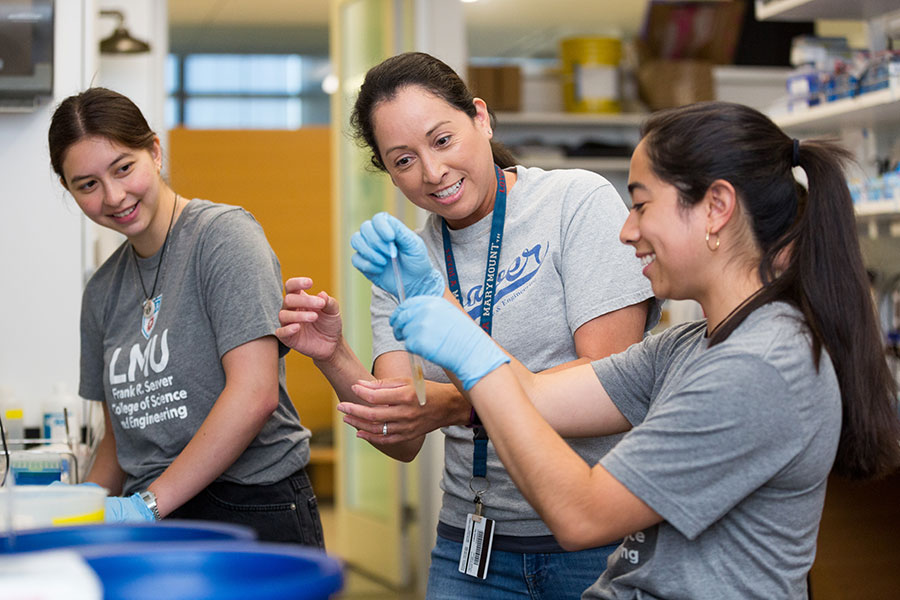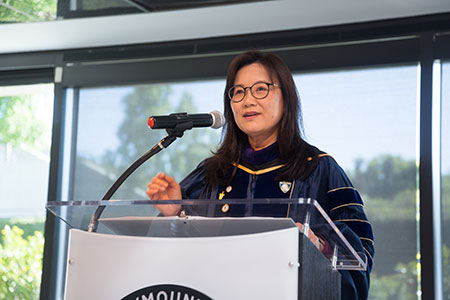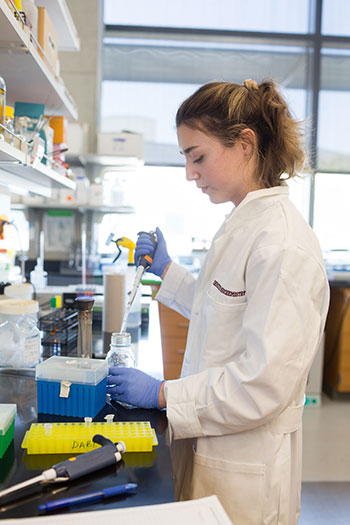
Half a century ago, looking out over the bluff from Loyola Marymount University’s Westchester campus (LMU), you would see miles of barely developed land extending toward the sea. Today, LMU sits at the center of Silicon Beach, a tech hub that thrives on the principle that interdisciplinary practice is the key to innovation. The notion of disciplines colliding is a hallmark of creative culture and collaborative problem-solving, but that wasn’t yet the case in the early 1970s, when President Donald P. Merrifield, S.J., and a group of progressive LMU educators identified the urgent need for cross-fertilization within the fields of STEM. The result was a merger of the Biology, Chemistry, Mathematics, and Physics departments with the departments of Civil, Electrical, and Mechanical Engineering, establishing the college we now know as LMU Frank R. Seaver College of Science and Engineering.
The philosophy behind the merger was both prescient and practical, informed by emerging problems of globalization and technological change, and true to the university’s mission to serve the greater good. In the open letter announcing the merger, Merrifield expressed the need to move beyond siloed specialization in order to combat threats to public health and preserve diminishing natural resources. Today, national policymakers are finally catching up with those early intuitions, roused by the effects of rising climate change and the prospect of future pandemics.

Positive shifts in policy are incubated in educational institutions, and Seaver has been leading the way for decades. Each new development has actively built upon the founding philosophy of the college, reinterpreting the meaning and goals of interdisciplinary practice in the context of contemporary issues and technological opportunity. “The strategic introduction of new academic and student programs has always been guided by our mission to equip our students with a toolkit to understand and tackle complicated challenges,” explained Dean Tina Choe. “Hybridized majors and programs have been devised in direct response to changing global conditions – from early additions such as biochemistry and computer science, through to environmental science, health and human science, systems engineering, healthcare systems engineering, statistics and data science, and computer engineering, to name just a few.”
These academic programs are supported by an infrastructure of high-impact practices, providing students with practical experiential knowledge, mentorship, and exposure to industry leaders. As early as their first year at Seaver, students have the opportunity to engage in faculty-student research, internships, immersive global learning encounters, and learning communities such as the ACCESS program, designed to give students of all backgrounds a head start in STEM. “One such high-impact initiative is our Google Computer Science Summer Institute extension program, a partnership with Google that seeks to increase diversity in the fields of computing,” explained Choe. “Our commitment to student success has also led to a number of multidisciplinary research projects spearheaded by faculty and supported by undergraduate and graduate students, each project directly addressing social and environmental problems.”

In recent years, groundbreaking areas of research have included a project between the Computer Science Department and LMU Loyola Law School, applying techniques of data mining to identify cases in which an individual has been unjustly incarcerated. Another collaboration, the SeafoodTracer project funded by the NSF Convergence Accelerator, brings together the departments of Biology, Physics, Computer Science, Engineering, and Chemistry with the shared goal of combatting illegal fishing and aiding seafood regulation compliance. The university’s proximity to the ocean has also inspired the founding of LMU Coastal Research Institute, where students and faculty from science and engineering departments examine how climate change is affecting Santa Monica Bay.
The breadth and ambition of these initiatives is mirrored in the work of the college’s many distinguished alumni. One such individual is Robert Sclabassi ’62, whose career is a superb example of what interdisciplinary practice looks like professionally. Having originally studied electrical engineering at LMU, Sclabassi later applied his training to his work in healthcare and entrepreneurship. He is CEO of Computational Diagnostics, Inc., managing partner of Clinical Neurophysiological Services, and holds both a medical degree and a PhD in electrical engineering. He is licensed to practice medicine in four states, and he is also a PE (Professional Engineer) who has published over 500 scientific papers and has 18 patents to his name. While Sclabassi’s career has taken many extraordinary turns, he observes that each transition arose with a “naturalness” that he credits to his LMU education. “The disciplines of medicine and electrical engineering may seem diametrically opposed, but for me they’re wholly consistent fields of study,” he explained. As Sclabassi sees it, the ability to recognize that consistency – and to innovate accordingly – was due in part to the broad curriculum of a Jesuit education as well as a training in reflection and discernment. “I tend to think about things in a very purposeful way,” he said. “If combining different practices will benefit society and the people around me, then it makes sense to follow that route.”
Sclabassi makes the process of problem-solving sound simple – a mindset shared by Dorota Shortell ’98, whose socially-conscious engineering company, Simplexity Product Development, specializes in designing highly complex products in a simple and effective way. For Shortell, it’s imperative that the company engages in projects that have a positive impact – an ethic that was instilled in her during her time studying mechanical engineering at LMU. Moreover, the culture at LMU provided her with a model for the environment she wanted to create at Simplexity. “Having been part of a community that prioritizes being a person with and for others, it’s important to me that Simplexity is a great place to work – where everyone is treated fairly and people can speak their mind. That’s one of the things I took away from my education – the value of a culture that truly fosters excellence.”
That culture of creative openness and inclusivity isn’t always typical in the workplace – nor is it typical to be a woman leading an organization within traditionally male-dominated fields. It’s a challenge that Choe knows only too well, as the first woman to be appointed dean of Seaver. Choe joined LMU as a chemistry professor 27 years ago, and as dean she has committed to recruiting exceptional teacher-scholars who better represent the diversity of society; a team of thought-leaders and pedagogical innovators motivated to create transformative learning opportunities for their students. Equally important to Choe is the need to provide an optimal environment for students and faculty to thrive, and over the last two decades, she has overseen multiple capital projects.
In recent years, the expansion of research and collaboration has called for a series of new building projects and strategic renovations. In 2015, the $110M Bruce Featherston Life Sciences Building set new standards for a learning environment centered on hands-on learning and ecological sustainability. In 2017, the $1.25M renovation of the Cheryl and Robert Gross Engineering Design Center optimized opportunities for student teamwork. The next major development will be the state-of-the-art Engineering Innovation Complex – a building designed to foster interdisciplinary projects and new advances in STEM, while simultaneously serving as a hub for industry leaders to gather and share ideas. “For 50 years, our Seaver faculty, students, and alumni have contributed to LMU’s advancement of science and boldly integrated STEM into our human future as inventors, entrepreneurs, creators, and educators,” said LMU Provost Thomas Poon. “The addition of the Engineering Innovation Complex will enable collaborations and outcomes that honor our traditions and provide opportunities to uplift our collective creativity and global partnerships.”
This next phase of expansion is indicative of the strategic commitment to align academic excellence and external influence, granting students a seamless transition between their days on the bluff and their future careers. Sclabassi and Shortell are among the many alumni of the college who clearly demonstrate the connection between selfless service and personal success, and the current generation of LMU students are each discovering what that means for themselves. Their stories will define the evolution and impact of Seaver in the decades to come; their actions will shape the course of the next 50 years.
To support Frank R. Seaver College of Science and Engineering, contact Melissa Watkins, executive director of development, at melissa.watkins@lmu.edu or 310.338.3795 or visit here.



